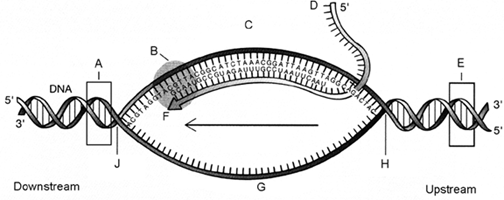Refer to Figure 13-3.The transcription process most likely began at the area labeled:

a. A.
b. D.
c. E.
d. G.
e. F
C
You might also like to view...
The hypothesis that mitochondria and chloroplasts originated from the phagocytic activity of
prokaryotes that was not followed by digestion is called the
a. theory of natural selection. b. endosymbiotic hypothesis. c. ribozymes-first hypothesis d. Oparin-Haldane hypothesis. e. stromatolite hypothesis
Where are MHC_II cell surface proteins found?
A. macrophages, B cells, and dendritic cells B. erythrocytes C. acidophils D. neutrophils E. neutrophils and macrophages
Which of the following have been used to produce
biofuels? a. algae b. soybeans c. rapeseed d. flaxseed e. all of these
Why isn't mitochondrial DNA a unique identifier?
A. Mitochondrial DNA is inherited through the maternal lineage. All offspring inherit their mother's mitochondria, and therefore the same mitochondrial DNA. As a result, all family members that share a maternal lineage would have the same mitochondrial DNA. Mitochondrial DNA can therefore be used to confirm or eliminate a person's relationship within a maternal line, but cannot be used to identify a specific individual. B. Mitochondrial DNA is inherited through the maternal lineage. All female offspring inherit their mother's mitochondria, and therefore the same mitochondrial DNA. As a result, all female family members that share a maternal lineage would have the same mitochondrial DNA. Mitochondrial DNA can therefore be used to confirm or eliminate a person's relationship within a maternal line, but cannot be used to identify a specific individual. C. Mitochondrial DNA is inherited through the paternal lineage. All offspring inherit their father's mitochondria, and therefore the same mitochondrial DNA. As a result, all family members that share a paternal lineage would have the same mitochondrial DNA. Mitochondrial DNA can therefore be used to confirm or eliminate a person's relationship within a paternal line, but cannot be used to identify a specific individual.